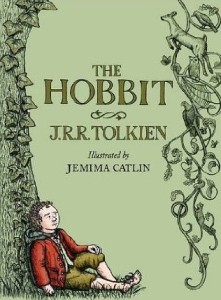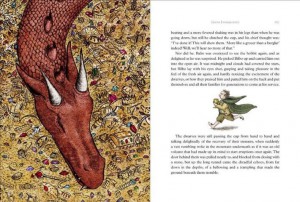 By now you’re undoubtedly aware of the newest edition of The Hobbit, illustrated in gorgeous and whimsical fashion by Jemima Catlin.
By now you’re undoubtedly aware of the newest edition of The Hobbit, illustrated in gorgeous and whimsical fashion by Jemima Catlin.
She was just 23 when artwork she’d created for a personal project on Tolkien’s short story Rover Random came to the notice of literary giants Harper Collins -– and eventually landed her a contract to illustrate The Hobbit.
Here, Tolkien Library chats with her about how it all happened.
Q. Dear Jemima Catlin, it is so nice to be able to talk with you about your illustrations for The Hobbit! But can you first tell us a bit more about yourself?
I was born in Dorchester, Dorset UK in 1986. I have always wanted to be an illustrator from a very young age and began writing my own stories and illustrating them from the age of 8. I come from quite a creative background; my Mother is an artist and writer, and my Father is a professional photographer. After A levels I studied a Foundation Diploma in Art and Design at Weymouth College, and then went on to do a Foundation Degree in Visual Communication at the Arts University at Bournemouth, followed by a BA Honours Degree in Illustration.
Q. When did you get into touch with Tolkien’s works for the first time?
I first read The Hobbit when I was 12 and I loved it – I couldn’t put it down! My Grandfather was a Tolkien book collector, and it is sad he wasn’t around to see that I illustrated The Hobbit. The first ever Middle Earth inspired drawing I did was for my sister’s wedding table plan in 2008; I drew two huge Ent’s with the table names at the ends of the branches. Then when I was at university, I decided to illustrate the short story Roverandom by J R R Tolkien for my final major project.
 Q. I have read you started out by illustrating another tale by Tolkien, namely Roverandom. Why did you choose to illustrate this small tale?
Q. I have read you started out by illustrating another tale by Tolkien, namely Roverandom. Why did you choose to illustrate this small tale?
I found the varying environments and unusual characters in Roverandom very inspiring, I really enjoyed illustrating it. Being a short story, it was the perfect length for my project as we only had 3 months to complete it. I illustrated it using monoprint techniques, which involves drawing on a piece of paper placed over a sheet of glass covered in printing ink, the drawing is then picked up by the ink on the other side of the paper creating a reverse image. The result is a lot less detailed than conventional ways of drawing, but adds spontaneity and movement to the illustrations.


